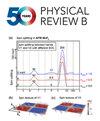Quasiparticle wave function and its equation of motion
IF 3.7
2区 物理与天体物理
Q1 Physics and Astronomy
引用次数: 0
Abstract
The quasiparticle wave function of a many-electron system is traditionally defined as the eigenfunction of the quasiparticle eigenvalue equation involving the self-energy. In this article a different concept of a quasiparticle wave function is derived from the general definition of the Green's function without reference to self-energy. The proposed quasiparticle wave function can decay in time, and in contrast to the traditional one it contains not only the main quasiparticle mode but also other modes due to coupling to collective excitations in the system. In the recently developed dynamical exchange-correlation potential formalism, this definition of a quasiparticle wave function leads to an equation of motion with an effective field, which appears to have a simple form expected to be amenable to realistic approximations. A simple model for the effective potential is proposed which is suitable for materials whose valence electrons are dominated by itinerant s−p electrons such as simple metals.求助全文
约1分钟内获得全文
求助全文
来源期刊

Physical Review B
物理-物理:凝聚态物理
CiteScore
6.70
自引率
32.40%
发文量
0
审稿时长
3.0 months
期刊介绍:
Physical Review B (PRB) is the world’s largest dedicated physics journal, publishing approximately 100 new, high-quality papers each week. The most highly cited journal in condensed matter physics, PRB provides outstanding depth and breadth of coverage, combined with unrivaled context and background for ongoing research by scientists worldwide.
PRB covers the full range of condensed matter, materials physics, and related subfields, including:
-Structure and phase transitions
-Ferroelectrics and multiferroics
-Disordered systems and alloys
-Magnetism
-Superconductivity
-Electronic structure, photonics, and metamaterials
-Semiconductors and mesoscopic systems
-Surfaces, nanoscience, and two-dimensional materials
-Topological states of matter
 求助内容:
求助内容: 应助结果提醒方式:
应助结果提醒方式:


